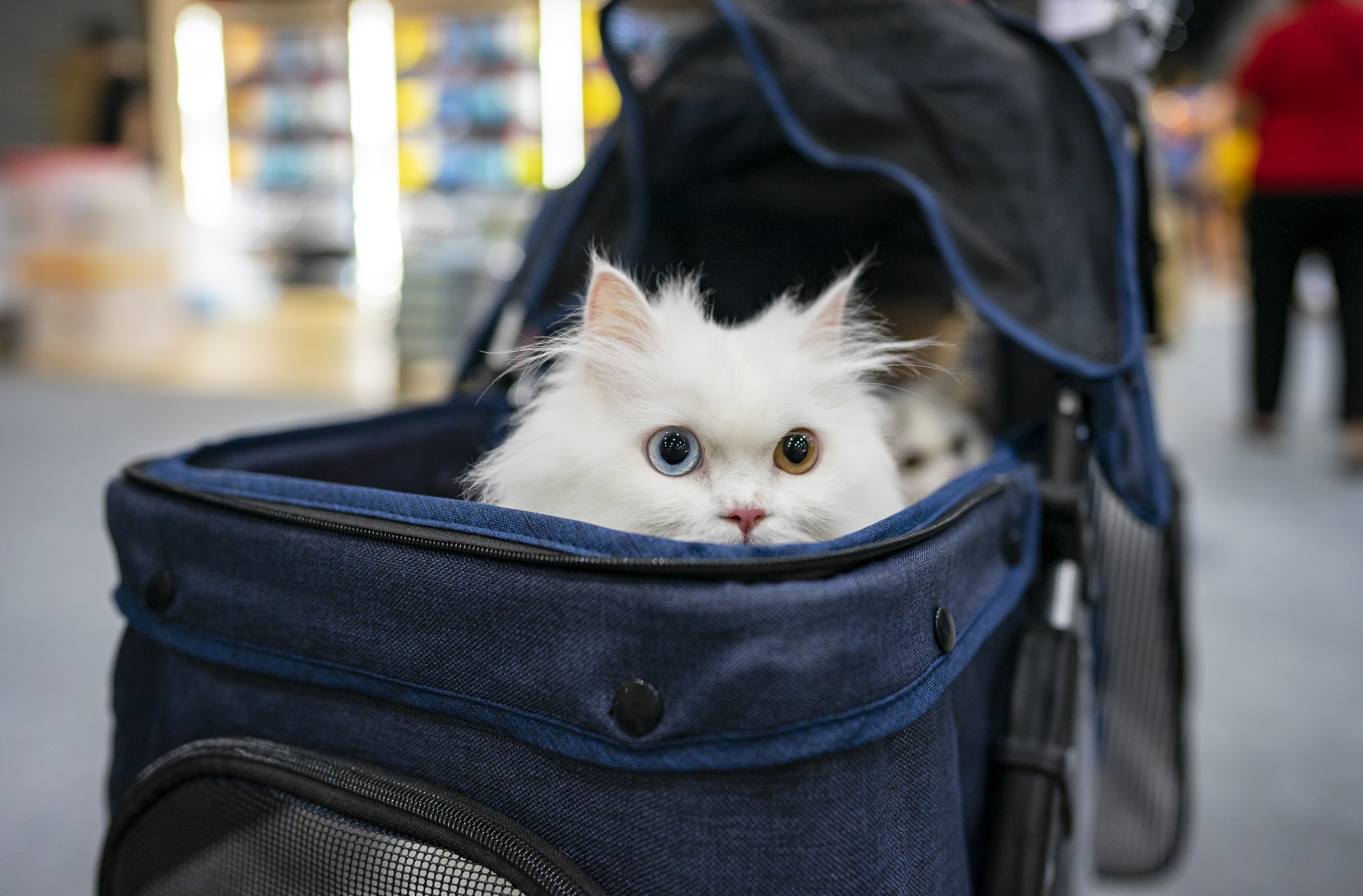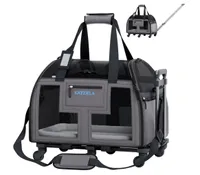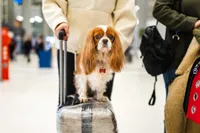What to Know Before Flying With Your Pet
From documentation and TSA screening to carrier rules and airport relief areas, here’s what to know before taking your pet on a flight.

For some reason, airlines have not been able to adjust to the growing demand for pet travel. In fact, most airlines don’t have policies at all for pets that are larger than a carrier that can fit under the seat in front of you.
And if your pet does fit in a carrier, there are strict rules in place that configure around carrier size, shape and even the types of animals that are allowed to travel. For most major airlines, dogs and cats are both allowed, but they have to be a certain age.
It’s no wonder that more and more people are choosing to forgo their vacations altogether, due to not knowing what to do with their pets, or being unable to afford the $150 fee most airlines charge per flight to bring a pet.
From just $107.88 $24.99 for Kiplinger Personal Finance
Become a smarter, better informed investor. Subscribe from just $107.88 $24.99, plus get up to 4 Special Issues

Sign up for Kiplinger’s Free Newsletters
Profit and prosper with the best of expert advice on investing, taxes, retirement, personal finance and more - straight to your e-mail.
Profit and prosper with the best of expert advice - straight to your e-mail.
According to Trusted Housesitters, more than half (56%) of US pet owners say they travel less since getting a pet. And, 22% of pet owners choose road tripping instead of flying, so they don’t have to keep track of all of the airline rules.
But sometimes road tripping just isn’t feasible. If you have a flight planned for this summer with your pet, make sure you understand the rules for each airline. In general, here are some of the best tips to ensure your flight with your furry friend goes as smoothly as possible.
What documentation you need to fly with your pet

Just like when traveling with your human family, your pet family members will need to check into their flight with the proper documentation. The Animal and Plant Health Inspection Service within the U.S. Department of Agriculture (USDA) is one of the best websites to familiarize yourself with in order to keep track of everything you’ll need for pet travel.
For the purposes of this article, we’ll focus on domestic travel. But if you are traveling internationally, just know that the rules and regulations are totally different and may require more time and planning in order to obtain the proper documentation in hard copy.
For domestic travel, the USDA doesn’t require its own documentation and will not monitor your trip. However, they say that the first thing you should do is reach out to your veterinarian to come up with a travel plan. This is because “your destination state or territory may have animal health requirements, such as obtaining a health certificate, updating vaccinations, diagnostic testing, or administering treatments,” according to the USDA website.
Airline-approved rolling pet carrier for small animals. Wheels can be removed to fit carrier under the seat in front of you. Mesh window sides. TSA compliant.
Additionally, if you’re flying with your pet, you will need signed documentation from your vet that your pet is healthy enough to travel. This will vary from airline to airline, but in general, most airlines require two hard copies of a health certificate for your pet that’s signed and dated by your vet within 10 days of your flight arrival time.
According to American Airlines, your health certificate should include the following: Your pet's breed, weight and date of birth or age. It should also include a statement that your pet was examined by a veterinarian and was found to be “free of infectious or contagious diseases that might put your pet, other animals or public health at risk.” This should also confirm that your pet appears to be healthy enough for travel.
Most airlines also require a document detailing the dog’s breed, a statement saying there’s no risk of birthing from your animal during its flight, proof of rabies vaccination, a customer acknowledgement form and temperature acclimation documentation. It’s no wonder most people choose to forgo flights with their pets altogether.
Tips to make flying with your pet less stressful

Each airline has different carrier rules for pet travel, but in general, your dog or cat must fit in a soft-sided carrier that fits under the seat in front of you. But once you have the basics out of the way, here are a few more tips that can help you travel with your pet with ease.
Bring Food and Water Bowls - You will need to think ahead of time about your pet’s food and water needs. If you want to travel light, consider collapsible travel bowls. Make sure to bring enough food for your travel day, and extra in case your flight gets delayed or you’re stranded somewhere overnight.
Know Your Airport’s Pet Relief Policy - Did you know that not all airports are required to have pet relief areas? In fact, only airports that serve 10,000 or more passengers a year are required to have pet relief areas, according to U.S. federal regulations. The American Kennel Club rounded up a list of the top 10 pet-friendly airports here.
Getting through TSA - The Transportation Security Administration (TSA) does have clear rules about flying with pets on its website. They will be screened through security just as you are.
However, pets must be placed in carriers. Just before you place your items through the x-ray, you will remove your pet and put the carrier through the x-ray. The TSA also recommends acclimating your pet with their carrier before flying, so they will feel safe and comfortable inside it.
Liberty Mutual Pet Insurance offers customizable coverage for accidents, illnesses, and routine care, helping you manage unexpected vet bills.
Bottom line
Flying with your pet takes extra planning, but it doesn’t have to be stressful. By understanding airline requirements, gathering the right documentation, and preparing for your pet’s comfort and safety, you can make air travel a positive experience for both of you. Whether it’s your first time flying with a furry companion or you’re a seasoned traveler, staying informed will help you navigate the journey with confidence.
related content
Profit and prosper with the best of Kiplinger's advice on investing, taxes, retirement, personal finance and much more. Delivered daily. Enter your email in the box and click Sign Me Up.

Brittany Leitner is a freelance journalist with over 10 years of experience in lifestyle, health, and more. She received a Digital Health Award for her reporting in 2019 as well as numerous awards for her work in poetry. She previously held positions as senior editor at Elite Daily and managing editor at The Dr. Oz Show. Follow her online @britariail.
-
 3 Ways to Stretch the 2026 Social Security COLA For Your Budget
3 Ways to Stretch the 2026 Social Security COLA For Your BudgetThree steps retirees can take to stretch the Social Security COLA to fit their budgets.
-
 How to Keep Your Charitable Giving Momentum Going All Year
How to Keep Your Charitable Giving Momentum Going All YearInstead of treating charity like a year-end rush for tax breaks, consider using smart tools like DAFs and recurring grants for maximum impact all the year.
-
 Uber Takes Aim at the Bottom Lines of Billboard Lawyers
Uber Takes Aim at the Bottom Lines of Billboard LawyersUber has filed lawsuits and proposed a ballot initiative, in California, to curb settlements it claims are falsely inflated by some personal injury lawyers.
-
 Uber Takes Aim at the Bottom Lines of Billboard Personal Injury Lawyers
Uber Takes Aim at the Bottom Lines of Billboard Personal Injury LawyersUber has filed lawsuits and proposed a ballot initiative, in California, to curb settlements it claims are falsely inflated by some personal injury lawyers.
-
 11 Cities With the Cheapest Groceries in the US
11 Cities With the Cheapest Groceries in the USIf you live in one of these 11 cities, you're paying less than the rest of the country to keep your fridge stocked.
-
 Giving Tuesday 2025: 'Every Small Act Makes a Major Difference'
Giving Tuesday 2025: 'Every Small Act Makes a Major Difference'GivingTuesday encourages generosity in any form, from donating to charity to helping your neighbors.
-
 How to Position Your Portfolio for Lower Interest Rates
How to Position Your Portfolio for Lower Interest RatesThe Federal Reserve is far from done with its rate-cutting regime. This is how investors can prepare.
-
 Moves to Manage the Soaring Costs of Owning a Car
Moves to Manage the Soaring Costs of Owning a CarIt's costing more and more to keep a car on the road, but you can drive some costs down. Here's how to get a better deal on insurance premiums, repairs and gas
-
 My First $1 Million: Oil Industry Engineering Manager, 67, Chapel Hill, N.C.
My First $1 Million: Oil Industry Engineering Manager, 67, Chapel Hill, N.C.Ever wonder how someone who's made a million dollars or more did it? Kiplinger's My First $1 Million series uncovers the answers.
-
 I'm a Financial Literacy Expert: Bubble-Wrapping Our Kids Robbed Them of Resilience. Now What?
I'm a Financial Literacy Expert: Bubble-Wrapping Our Kids Robbed Them of Resilience. Now What?By raising them to think they're amazing no matter what and lifting them over obstacles, we left them unprepared to work in the real world.
-
 I'm a Financial Planner: If You're a High Earner, You Need an 18-Month Safety Net
I'm a Financial Planner: If You're a High Earner, You Need an 18-Month Safety NetNo job seems to be safe in this age of AI. If you make a larger-than-usual salary, then you need to have a larger-than-usual emergency fund. Here's why.

